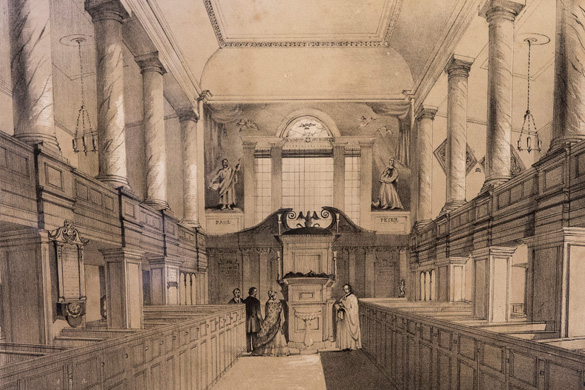Pulpit
In 1742, in the rebuilt chapel, the Georgians placed a three decker pulpit in the centre of the aisle where the pew pattern widens out. It had a place for the chapel clerk, the Bible and from the highest level the minister preached. It was the focal point, as in many Non-conformist chapels of the period. For those in the galleries it meant the only person visible downstairs during a service was the minister when he climbed the steps to preach. As a visiting Bishop of Stockport expressed it from the current pulpit, a remnant of the original: “ he was six feet above contradiction”. He was also, as is still the case, at the position in the church where without amplification his voice could be clearly heard. Acoustically the design is excellent!
The sketch, dated 1847, [ see also John Hughes in People and Memorials] shows the original pulpit, which was taken down in 1877 and replaced with a bulbous Jacobean pulpit. In 1985 the Jacobean pulpit was removed and the remaining section of the Georgian pulpit was remade so that it could moved, to create a more flexible central space. This has enabled worship to vary, and encouraged drama and music in the church.
A hundred years before the original pulpit was taken down John Wesley preached to the minister, mayor, aldermen and leading gentlemen of the town. His Journal records:
Thurs April 3rd 1788: In the evening I preached at Congleton. Part of the congregation were the Minister [Samuel Williamson], the Mayor [Bowyer Leftwich Wynn] with several Aldermen, but they seemed astonished while I opened and strongly applied, “Thou shalt have no other Gods before me.”
Mon 29th April 1790: In the evening I preached at Congleton. The Minister [Samuel Williamson], the Mayor [Robert Hodgson], and all the heads of the Town were present; so that I might not overshoot them, I preached on Psalm XC 12: and, I believe, God applied it to their hearts. [Teach us how short our life is, so that we might become wise]


